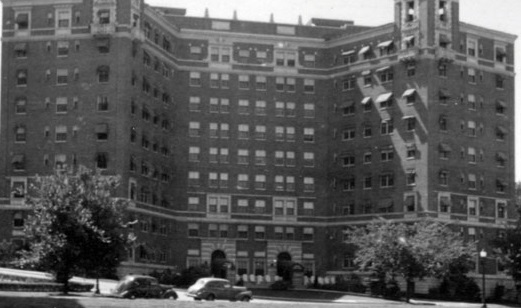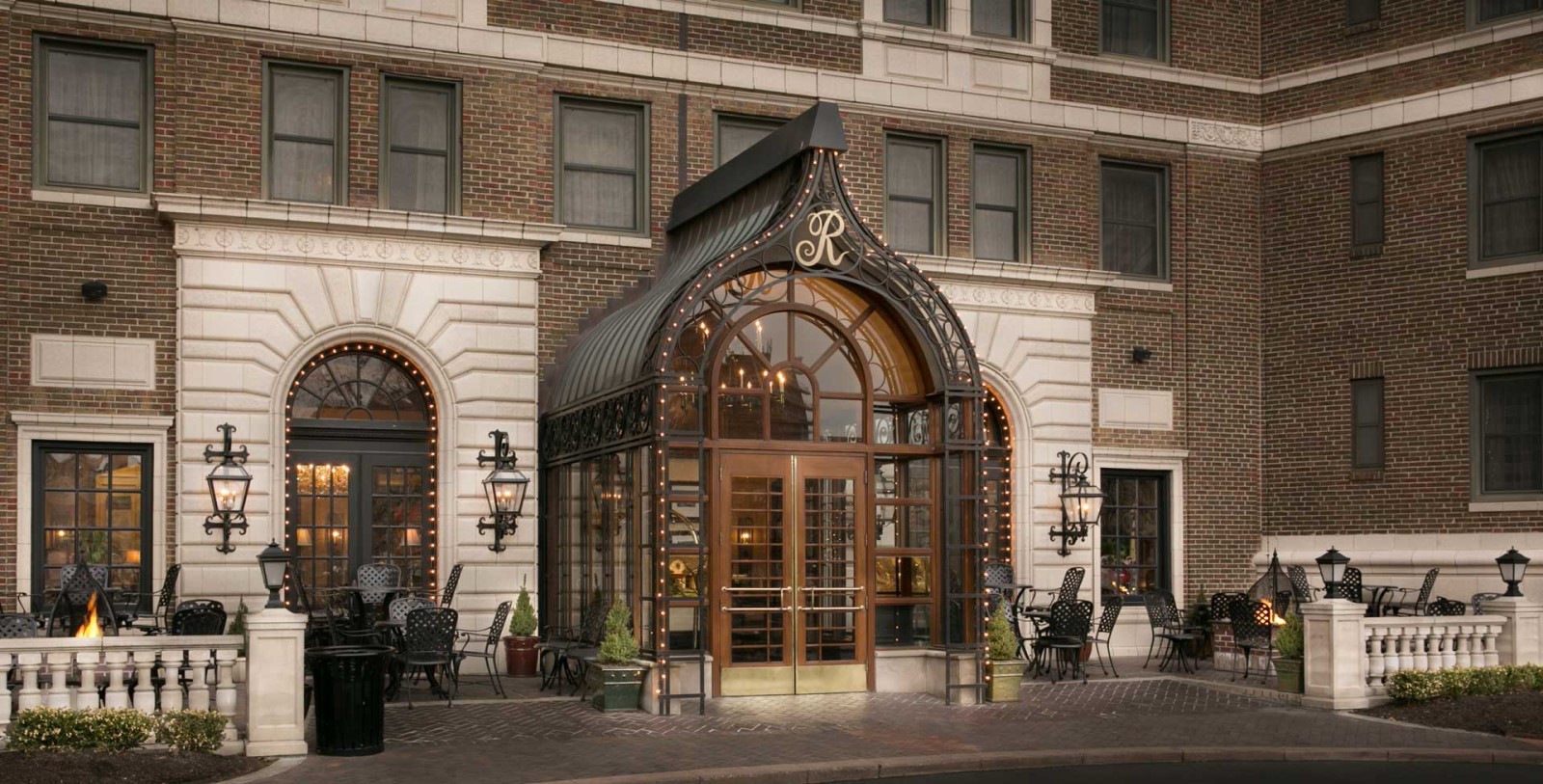Receive for Free - Discover & Explore eNewsletter monthly with advance notice of special offers, packages, and insider savings from 10% - 30% off Best Available Rates at selected hotels.
history
Discover the Raphael Hotel, a Kansas City landmark offering contemporary European charm and character to guests from around the world.
The Raphael Hotel, a member of Historic Hotels of America since 2001, dates back to 1928.
VIEW TIMELINEListed on the U.S. National Register of Historic Places by the U.S. Department of the Interior, The Raphael Hotel, Autograph Collection, has been a member of Historic Hotels of America since 2001. It is one of Kansas City’s most celebrated historical landmarks as well, having stood in the renowned County Club Plaza for a century. The building’s life originally began as a housing complex known as the “Villa Serena Apartments,” which first debuted during the 1920s. It had been built by two brothers who jointly operated a construction business known as the “McCanles Building Company.” Upon purchasing three plots of land from J.C. Nichols a few months earlier, both men had endeavored to create a magnificent apartment building right in the heart of Kansas City. (Nichols himself had obtained the lots from a nursery and floral shop, platting them for use as the “Loma Linda” subdivision.) To make their dream a reality, the brothers hired architect Alonzo Gentry to spearhead its design. He subsequently used Italian Renaissance Revival-style architecture as the source of his inspiration, hoping that such an aesthetic would blend the building seamlessly with the other Spanish and Mediterranean-inspired structures in Country Club Plaza. The McCanles Building Company spared no expense either, ultimately spending a total of $8 million in today’s money to finance its development.
When the building finally opened in 1928, it was thus widely considered to be an engineering masterpiece. It continued to operate as an apartment building for the next five decades, until the J.C. Nichols Company acquired it during the 1970s. J.C. Nichols Company had specifically opted to renovate the entire building into a hotel modeled after the elegantly small hotels of Europe. The whole structure in turn was subsequently reborn as “The Raphael Hotel” a year later, following an extensive renovation that faithfully preserved its vintage design. Impressively, the new hotel's immediate success helped pioneer the now-popular niche of the “boutique hotel.” (Revolutionary at the time, the concept was cultivated to create an individualistic hotel with European charm, character, and intimacy, while also offering personalized service at an exceptional value.) After operating The Raphael Hotel for some time, the J.C. Nichols Company proceeded to sell the enterprise to Philip Pistilli in 1989. Pistilli was an accomplished hotelier in his own right, having supervised The Raphael Hotel’s renovation a decade prior. Then in July of 2005, the Walker family of Salina, Kansas, purchased the building through its own hospitality corporation, Lighthouse Properties. They immediately invested millions into restoring The Raphael Hotel back to its former glory, taking great pains to ensure that its architectural integrity remained perfectly intact.
The Walkers strove to guarantee that The Raphael Hotel possessed only the finest amenities and services, including high-speed internet access and high-definition televisions. Lasted for nearly six years, the restoration comprehensively revitalized the hotel’s wonderful guestrooms and public spaces. The Raphael Hotel subsequently reopened before great local acclaim in 2010, earning significant praise for its restored architectural character and terrific level of service. In fact, the revitalized hotel went on to earn many distinctive accolades, including the distinguished “Four Diamond Award” from the American Automobile Association, as well as the noted Forbes Travel Guide Four Star rating. Furthermore, The Raphael Hotel was also voted to the prestigious “2015 T+L 500 World’s Best Hotels” by Travel + Leisure magazine and a recipient of TripAdvisor’s elite “Certificate of Excellence Hall of Fame Award.” More recently in 2020, Historic Hotels of America even bestowed The Raphael Hotel with one of its prestigious Awards of Excellence, specifically citing the site as the “Best Historic Hotel (76-200 Guestrooms).” Now under the new ownership of Bentley Legacy Holdings, this terrific historic hotel has since been relaunched as “The Raphael Hotel, Autograph Collection.” It remains one of the best destinations to visit in all Kansas City, too, offering nothing but the best in contemporary comfort.
-
About the Location +
The Raphael Hotel is one of the central locations in Kansas City’s renowned County Club Plaza. The plaza first came into existence at the start of the 20th century, when real estate developer J.C. Nichols began acquiring several plots of land along Ward Parkway near Brush Creek. Nichols was already well regarded throughout the city for his work creating attractive residential and commercial neighborhoods, the most notable being his “Country Club District” located just south of today’s Loose Park. (Loose Park was once part of the prestigious Kansas City Country Club, which originally opened in 1896.) Yet, many in the city thought that his plan was a mistake, often referring to it as “Nichols Folly.” This was due to the fact that the land was considered to be very unattractive at the time, as most had been reserved exclusively for pig farming. Nichols pushed forward with his vision in spite of the criticism, employing architect Edward Buehler Delk to design the first iterations of his mixed-use shopping district. Delk envisioned a brilliant sprawling series of towering buildings that used beautiful combinations of Spanish and Mediterranean-themed architecture for its appearance. Construction began in 1907 and took the better part of three decades to finish. Nevertheless, the facility debuted to thunderous applause when it finally opened as the “Country Club Plaza” in 1923, becoming an overnight sensation throughout Kansas City. For decades, some of the finest shops operated from within the Country Club Plaza, such as Sear’s, Woolworth’s, Harzfeld’s, and Jack Henry’s Clothing. Many more unique businesses called the plaza home as well, like a bowling alley, movie theater, a grocery store, and several exclusive restaurants. Some entrepreneurs decided to open a few upscale apartments in the district, too, including the Villa Serena Apartments that the owners of the McCanles Building Company had developed. By the 1970s, the Country Club Plaza was regarded as one of Kansas City’s most popular shopping destinations. Dozens of high-end businesses fought to reserve a space in the center, including Polo Ralph Lauren, Saks Fifth Avenue, and FAO Schwarz. The Country Club Plaza continues to be rated among the best places to shop in the entire country, filled with many upscale vendors like Michael Kors, Cole Haan, and Tiffany & Co. All are sure to provide for hours of entertainment.
Kansas City itself is among the most historic cities in all of the United States, dating back to the first decades of the 19th century. French fur traders led by the Chouteau family traveled up the Missouri River from St. Louis to create a trading post in the area at the start of the 1820s. It was later joined by a rival settlement founded by John Calvin McCoy some ten years later called “West Port.” West Port gradually evolved into an important embarkation point for settlers eager to cross the Great Plains, serving as the starting location for those destined to travel along such famous historic frontier routes like the Santa Fe and Oregon trails. Enough people had moved to the area that the State of Missouri incorporated it as the “Town of Kansas” in 1850. (It then became a “city” some three years later.) It continued to play a major role in facilitating the settlement of the west, even as the political turmoil of the American Civil War tore at the very cultural fabric of its population. Given Missouri’s status as a slave state and its proximity to the Old Northwest, the city was fiercely divided between Confederate and Union sympathizers. Its significance as a gateway to the frontier also made it a strategic target for both the North and the South, with the notorious Confederate guerilla fighter, William C. Quantrill, conducting numerous raids in the vicinity throughout the war. The two sides ultimately clashed for complete control over the area in October of 1864, when a Union army led by General Samuel Curtis routed a Confederate one under the command of Sterling Price at the Battle of Westport. Fortunately, the city recovered swiftly once the conflict had ended, emerging as a prosperous manufacturing center, specifically for the meatpacking industry. Its population continued to swell, inspiring the community to re-charter itself as “Kansas City” in 1889. Kansas City remained an important socioeconomic center in the central United States, becoming home to Kansas City-style jazz music during the Roaring Twenties and Great Depression. Perhaps the greatest musician to popularize the aesthetic at the time was the great bandleader Count Basie, who played before sold-out crowds all over the city. Today, Kansas City has maintained its place as one of America’s most noteworthy destinations. It is home to countless cultural attractions, including The Nelson-Atkins Museum of Art, the Arabia Steamboat Museum, and the National World War I Museum at Liberty Memorial.
-
About the Architecture +
The Raphael Hotel was originally designed as the “Villa Serena Apartments” by noted architect Alonzo Gentry on behalf of the McCanles Building Company. Gentry desired to design the structure with Italian Renaissance Revival-style architecture, in order to integrate it more closely with the Spanish and Mediterranean-inspired buildings of the surrounding Country Club Plaza. The McCanles Building Company was specifically managed by two brothers, who, according to oral traditions, greatly distrusted one another. Some suspect that the presence of a peculiar eight-foot wall in the center of the building was a way of legally separating the two men once they started to supervise it together. Nevertheless, both men spared no expense in erecting the structure, spending a total of $8 million in today’s money to finance its completion—an astronomical number back in the 1920s. Italian Renaissance Revival architecture itself is a subset of a much large group of styles known simply as “Renaissance Revival.” Renaissance Revival architecture—sometimes referred to as "Neo-Renaissance”—is a group of architecture revival styles that date back to the 19th century. Neither Grecian nor Gothic in their appearance, Renaissance Revival-style architecture drew inspiration from a wide range of structural motifs found throughout Early Modern Western Europe. Architects in France and Italy were the first to embrace the artistic movement, who saw the architectural forms of the European Renaissance as an opportunity to reinvigorate a sense of civic pride throughout their communities. As such, those intellectuals incorporated the colonnades and low-pitched roofs of Renaissance-era buildings, with the characteristics of Mannerist and Baroque-themed architecture. Perhaps the greatest structural component to a Renaissance Revival-style building involved the installation of a grand staircase in a vein similar to those located at the Château de Blois and the Château de Chambord. This particular feature served as a central focal point for the design, often directing guests to a magnificent lobby or exterior courtyard. Yet, the nebulous nature of Renaissance Revival architecture meant that its appearance varied widely across Europe. As such, historians today often find it difficult to provide a specific definition for the architectural movement.

































